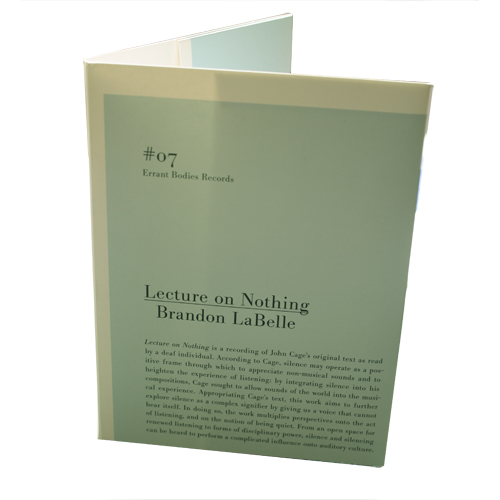Lecture on nothing.
BRANDON LABELLE
-text by John Cage, lecture by David Kurs-
(Errant Bodies 2011)
Review by John McEnroe
John Cage’s ‘Lecture on nothing’ is a text written between 1949 and 1950 that was first published on 1959 and later included on Cage’s book ‘Silence’. The text is presented with a certain rhythmic structure and should be read with the ‘rubato’ which gives rhythmic speed freedom to the lecturer looking, in this case, for a more ‘every day’ speech form.
On 2009 sound artist and theorist Brandon LaBelle appropriated this text by having a deaf person, in the case of the sound release -theater director and writer- David Kurs, to read ‘Lecture on nothing’. LaBelle took the notion of Cage where silence helps for the listener to be aware of the non-musical and incidental sounds and in general that silence can be a key perceptual element in the listening experience; The way LaBelle articulated Cage’s notion of silence and the ‘nothing’ is very poetic because is only possible to experience silence under deafness conditions. John Cage visited an anechoic chamber on a quest for silence and noticed the sounds of his blood and nervous system while he was expecting to hear ‘nothing’.
The experience when listening LaBelle’s ‘Lecture on nothing’ is complex and not an easy one. The obvious difficulties in Kern speech have a strong emotional effect at least on me as a listener and have to accept even touches what I could call some moral and ethical aspects of my persona which I guess totally misleads my reviewing process. Likewise the fact that Kurs, a person whose work implies sensibility, creativity and artistic sense, is the one reading the text gives to the project complete ethical insurance.
‘Short circuit’ by Brandon LaBelle from the early 2000’s was a very important text for me as it deals with a subject of great interest: the presence of sound art manifestations in the gallery / museum context. When I received ‘Lecture on nothing’ I really treasured it not only as a beautiful edition but also as an object. ‘Lecture on nothing’, unlike most releases we usually listen, does offer little ‘entertainment’ and instead puts the listener outside his comfort zone which is a situation that is more often found in an art exhibition that in the couch in our house with the lights off listening on a hi-end audio stereo system with a glass of single malt whiskey in our hands.
This sense of unease and discomfort is very important here as it is what helps triggering questions and reflections that hardly could arise on a comfortable entertaining situation. The concept behind the release is backed up with a very strong formal display that simultaneoulsy affects the listener intellectually and sensibly.
David Kurs doesn’t listen, he experiences silence. He might sense sound in a tactile way but he can’t listen. Now I wonder, bringing back Cage, how David Kurs’ experience with ‘real, silence draws him to somehow relate to the actual listening process. For David Kurs sound is an impossible as silence it is for us, it is something that occurs outside him, outside his senses; a notion, something he can only imagine. In the other hand when we use noise canceling devices, which provides something close to silence, our listening turns to the sound produced by own body as it happened with Cage’s experience on the anechoic chamber. Silence then appears as a metaphorical figure of listening to ourselves: a sort of internal path, a direction, a vector, which totally differs to a more common notion of silence as a state or condition.
LaBelle’s ‘Lecture on nothing’ is a ver powerful catalyst of ideas, reflections and questions about silence, about this thing that only occurs in our imagination; about how this ideal figure somehow connects with our sensible experience and in the end how silence can work as some sort of link to a universe beyond our senses as it happens to David Kurs with listening when he is reading Cage’s text.
Hardy can picture a better way to celebrate Cage’s centenary than by accessing ‘Lecture on nothing’ as it digs deep into our notions of listening and experiencing things in general.
[Brandon LaBelle photo courtesy of Migrating Art Academies]



